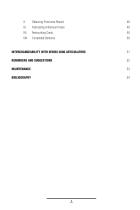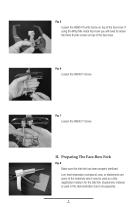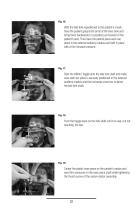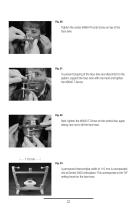 Website:
Whip Mix Corporation
Website:
Whip Mix Corporation
Catalog excerpts

Quick Mount
Open the catalog to page 1
Whip Mix 3000 Series Articulators
Open the catalog to page 2
OBTAINING FACE-BOW REGISTRATION 6 II. Preparing The Face-Bow Fork 7 III. Positioning The Face-Bow On The Patient 9 IV. Removing The Face-Bow From The Patient 12 V. Obtaining Interocclusal Records 13 DIRECT MOUNTING THE MAXILLARY CAST ON SERIES 3000 ARTICULATORS 19 I. Preparing The Articulator For Mounting Casts 19 II. Placing A Direct Mounting Face-Bow On The Articulator 22 III. Mounting The Maxillary Cast With A Direct Mounting Face-Bow 24 INDIRECT MOUNTING THE MAXILLARY CAST ON SERIES 3000 ARTICULATORS 27 I. Preparing The Face-Bow And Articulator For Mounting Casts 29 II. Placing The...
Open the catalog to page 3
X. Obtaining Protrusive Record 48 XI. Fabricating A Remount Index 49 XIII. Completed Dentures 50 INTERCHANGEABILITY WITH SERIES 3000 ARTICULATORS 51
Open the catalog to page 4
INTRODUCTION WHIP MIX Articulators and QUICK MOUNT Face-Bows are designed to enable the user to quickly and easily mount casts of a patient’s dentition on a mechanical device that will reproduce their natural relationship and movements with an acceptable degree of accuracy. The simplicity and speed with which the necessary registrations are obtained and transferred to a WHIP MIX Articulator enable the operator to accomplish corrective and restorative dentistry with much greater precision than has ever before been possible without the use of expensive equipment and time consuming techniques....
Open the catalog to page 5
OBTAINING FACE-BOW REGISTRATION Fig. 1 Items needed for a Face-Bow Registration: 1. Face-Bow with Nasion Relator Assembly and Face-Bow Fork (bite fork) 2. Compound or Wax Registration Material 3. Bard-Parker® Blade or similar instrument Clean and properly disinfect the plastic ear pieces before each use. If replacing them, make sure the hole on the flat side of each is above the side arm and the plastic is forced on until it touches the shoulder of the arm. A rubber band may be easily positioned on the face-bow to aid in its manipulation. Note the caliper design of the QUICK MOUNT...
Open the catalog to page 6
Loosen the #8604 Thumb Screw on top of the face-bow. If using the Whip Mix metal face-bow you will need to loosen the three thumb screws on top of the face-bow. II. Preparing The Face-Bow Fork Fig. 8 Make sure the bite fork has been properly sterilized. Low-heat impression compound, wax, or elastomeric are some of the materials which may be used as a bite registration medium for the bite fork. Elastomeric material is used in this demonstration due to its popularity.
Open the catalog to page 7
Place the elastomeric material uniformly over the top surface of the bite fork. Inspect the underside of the bite fork to ensure material is locked onto the bite fork via the retention holes. Position the bite fork so the mid-line of the bite fork aligns with the mid-line of the maxilla. Support the bite fork underneath by having the patient bite on cotton rolls. Some clinicians prefer to have the patient bite on the bite fork itself after registration material has been placed on both sides. Whichever registration technique is used, the goal is to record a shallow registration of the...
Open the catalog to page 8
Inspect the registration for any soft tissue or deep occlusal registrations. Soft tissue registrations and excess registration material may be easily cut away with a Bard-Parker ® Blade. Remember, it is only necessary to record the maxillary cusp tips! After trimming, place the registration back in the patient’s mouth and check for accuracy and stability. III. Positioning The Face-Bow On The Patient Fig. 14 Before attempting to place the face-bow onto the bite fork, it is suggested the operator rehearse the following procedure with the patient. Caution the patient thatthe plastic ear...
Open the catalog to page 9
With the bite fork repositioned in the patient’s mouth, have the patient grasp both arms of the face-bow and bring them backwards to a position just forward of the patient’s ears. Then have the patient place each ear piece in the external auditory meatus and hold in place with a firm forward pressure. Start the #8642 Toggle onto the bite fork shaft and make sure each ear piece is securely positioned in the external auditory meatus and the horizontal cross bar is above the bite fork shaft. Push the toggle back on the fork shaft until it is near, but not touching, the lips. Center the plastic...
Open the catalog to page 10
Tighten the center #8604 Thumb Screw on top of the face-bow. To prevent torquing of the face-bow and discomfort to the patient, support the face-bow with one hand and tighten the #8640 T-Screw. Next, tighten the #8643 T-Screw on the vertical bar, again taking care not to tilt the face-bow. A permanent intercondylar width of 110 mm is incorporated into all Series 3000 Articulators. This corresponds to the “M” setting found on the face-bow.
Open the catalog to page 11
Therefore, when mounting a cast on a Series 3000 Articulator, it is not necessary to record the intercondylar width marking designated by the S-M-L markings on the upper arm of the face-bow. IV. Removing The Face-Bow From The Patient Fig. 25 Loosen the #8604 Thumb Screw on the nasion relator assembly and slide the nasion relator assembly away from the patient. Have the patient hold both arms of the face-bow and loosen the center thumb screw on top of the face-bow. Note: If using Whip Mix metal face-bow, loosen the three thumb screws located on the top. Advise the patient to gently pull the...
Open the catalog to page 12
V. Obtaining Interocclusal Records There are several materials available which may be used to make interocclusal records. There are also different techniques and philosophies for making these records. The material selected should complement the particular technique used. The technique suggested in this manual is but one method and Whip Mix does not imply that this is the only technique one can use. The following interocclusal records (check bites) may be utilized to program the condylar guidance of the articulator: • Centric Relation and/or Maximum Intercuspation • Right Lateral • Left...
Open the catalog to page 13
Warm the wax record in water until the tooth-contacting edges are soft enough to offer no resistance. Position the wax record against the maxillary posterior teeth. Do not press against the teeth or you may perforate the thin record. Manipulate the mandible into centric relation. The maxillary and mandibular posterior teeth will automatically create “cuspal indents” in the wax. Maintain this position while cooling the wax with a stream of air until the wax is no longer soft, then instruct the patient to “snap open.”
Open the catalog to page 14All Whip Mix Corporation catalogs and technical brochures
-
Vericore Gradient Temp
2 Pages
-
Model Printing
2 Pages
-
Milling Services
2 Pages
-
Wax Tools
4 Pages
-
Denar Mark 300 Series
4 Pages
-
ProJet 3510MP
4 Pages
-
Asiga 3D Printer
22 Pages
-
Roland DWX-50 Flyer
2 Pages
-
ProJet 1200 Flyer
2 Pages
-
DWX-51D Brochure
4 Pages
-
DWX-4W Brochure
4 Pages
-
3Shape Brochure
4 Pages
-
DWX-4_brochure
4 Pages
-
Mark 300 Series
4 Pages
-
InStep
2 Pages
-
projet_3500_dental
4 Pages
-
wax_tools
4 Pages
-
Pro 200 Series
4 Pages
-
Denar® LabRelator
2 Pages
-
AquaSpense Brochure
2 Pages
-
Whip Mix Articulator Guide
8 Pages

























